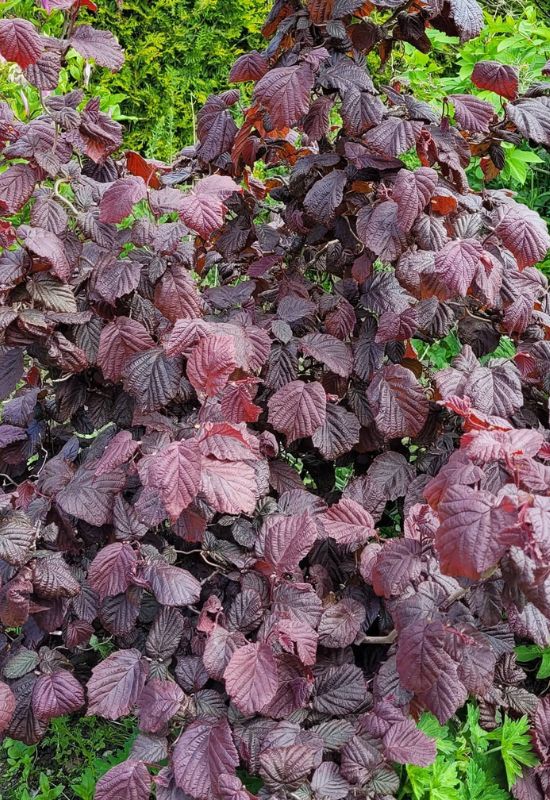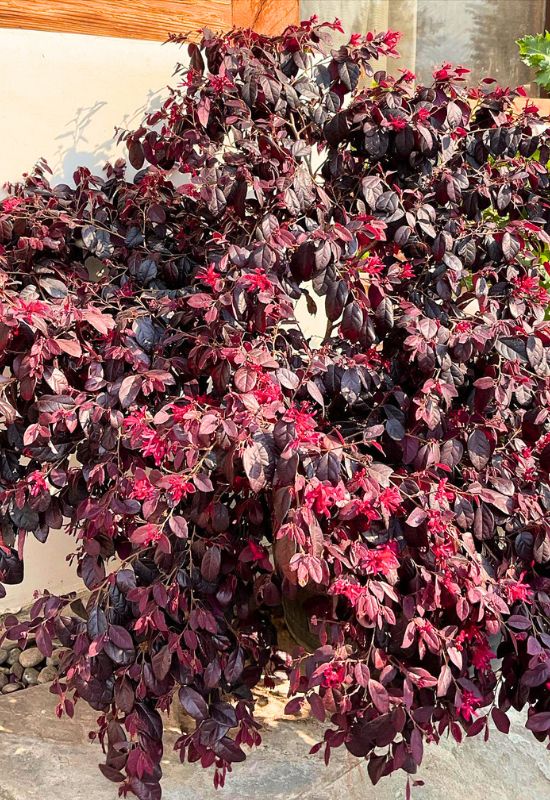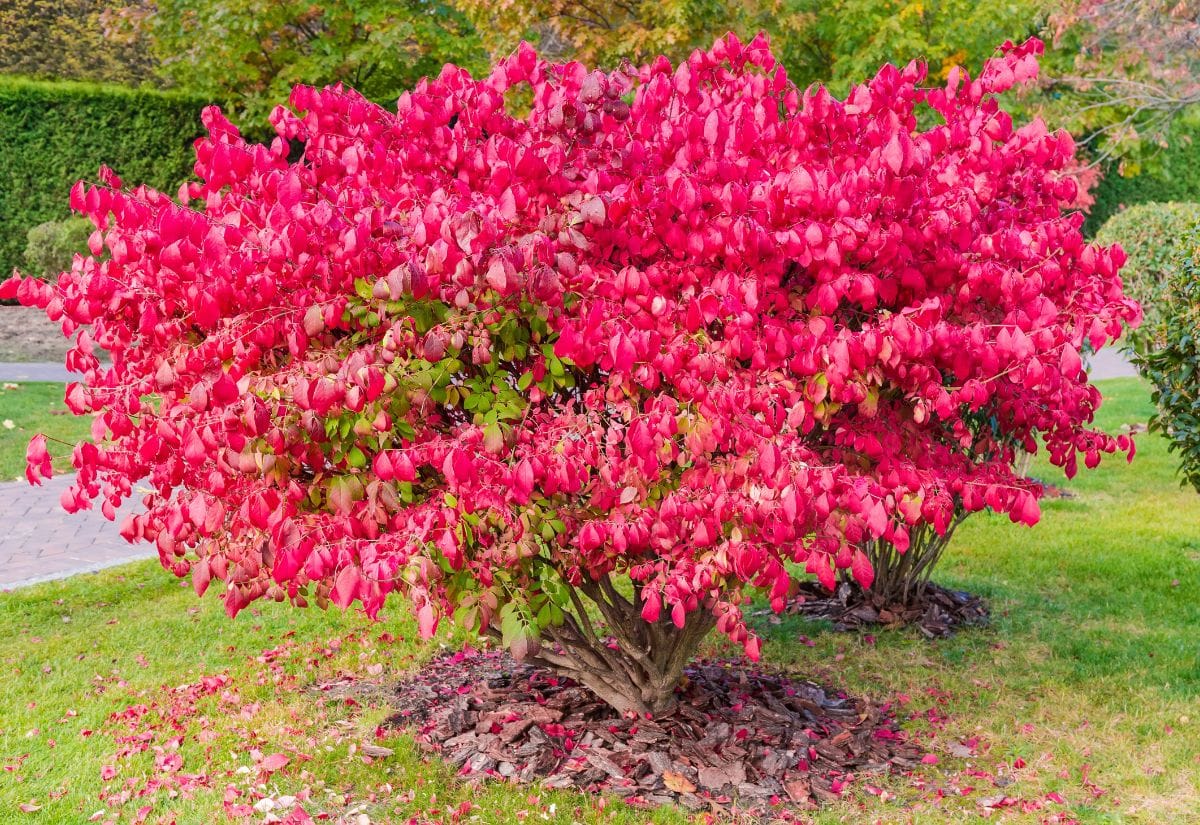
Red in the garden is a true treasure, brightening up every corner throughout the entire year. However, it’s quite a task to keep this splash of vibrancy consistent across all seasons. Only a select group of plants, some annuals included, manage to maintain shades of crimson or scarlet from spring through winter.
But there’s good news: certain shrubs are up to the task! These resilient shrubs retain their red leaves year-round, providing a striking focal point, creating a bold contrast with the green foliage of other plants, and injecting energy and warmth into your garden, even in the chilliest months.
It’s not just about the leaves; these red-leaved Shrubs also show off their red hues through fruits, berries, and occasionally, even their bark, making them a true feast for the eyes.
While the options may be limited, I’ve handpicked the best shrubs that guarantee a splash of red in your garden, ensuring a vibrant display from the blossoming days of spring and the warmth of summer, to the golden hues of fall and the quiet solitude of winter. So, get ready to transform your garden into a year-round spectacle of color and life!
8 Stunning Shrubs That Keep Their Red Leaves Through Every Season
As we said, there aren’t many shrubs that offer you the color red all year round, but here are 8 shrubs that stay radiantly red through every season!
So, let’s see why these are the “champions of red shrubs”!
‘Crimson Pigmy’ Japanese Barberry (Berberis thunbergii‘ Crimson Pigmy’)
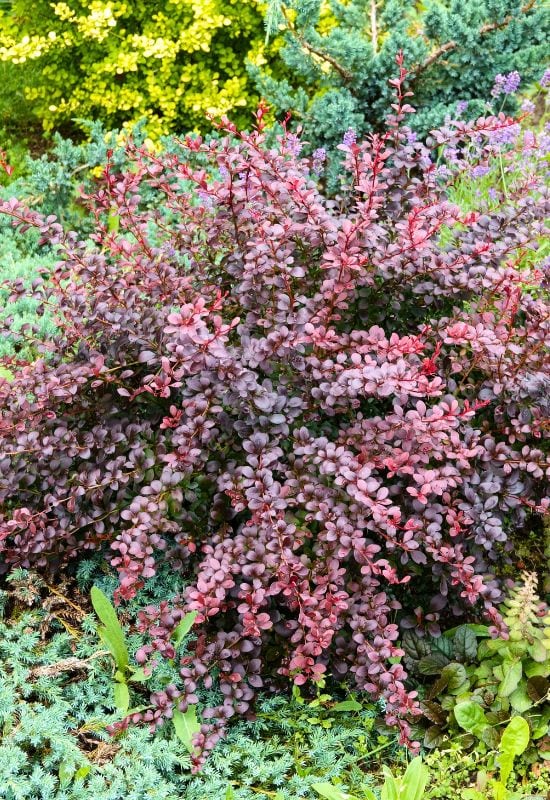
First on our list a dwarf shrub with a deceiving name: ‘Crimson Pigmy’ Japanese barberry. Not fully misleading, as it is small, but the actual color of the foliage is on another shade of red, ranging from cherry to garnet, so, very intense and emotional indeed.
The many small, ovate, waxy leaves form dense and finely textured carpets that keep this fiery glow all year round. The actual berries, however, small but very glossy, elongated, are actually bright red, closer, in fact, to crimson and they stay on though winter.
On the other hand, the flowers are small, pale green and inconspicuous, but they do have a special touch: a lovely sweet scent. This tiny bush with a bright personality had won the Award of Garden Merit by the Royal Horticultural Society.
The little size of ‘Crimson Pygmy’ Japanese barberry makes it ideal for small gardens, flower beds, rock gardens and even as red colored ground cover, and it is very low maintenance.
‘Red Majestic’ Hazel (Corylus avellana ‘Red Majestic’)
Hazel ‘Red Majestic’ is a new cultivar with something of our color all year round. This large shrub or small tree has deep wine red leaves, quite dense and broad, very showy indeed. But it is deciduous, so they will not stay on in winter, however… Pink red catkins, will keep the theme during the cold season!
While it is an easy to grow variety, it is a fairly expensive one, about $100 per plant. On the other hand, its impact in a garden is worth it, and you can then propagate it by cuttings. This extraordinary hazel has won the Award of Garden Merit by the Royal Horticultural Society.
Grow ‘Red Majestic’ hazel for a large splash of intense and deep red in hedges, borders along sideways or at the back of large borders, and you will have a red spectacle all year round.
Red Tip Photinia (Photinia x fraseri)
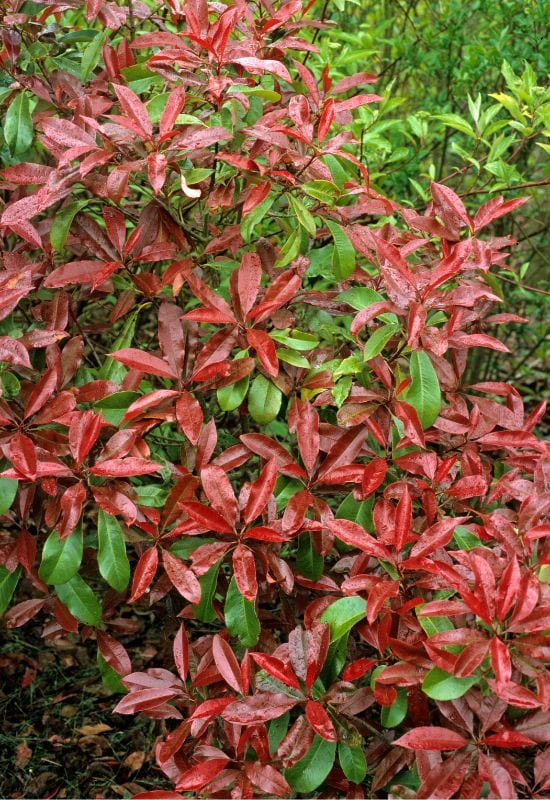
Red tip photinia, a.k.a. red robin shrub, is a very malleable evergreen bush with fiery red foliage at the top, while the rest is emerald green. From a distance, it looks like a fire on top of a lush field.
The leaves are broad, oval and quite glossy indeed. While the white flowers that come in spring are small, and they have an unpleasant smell, the fruits that follow and stay on for months are red and they look like berries. Moderately fast growing, vigorous and strong, it is also one of the best varieties on our list to prune.
And, in fact, you can even grow red tip photinia in formal gardens, because you can prune it into any shape, even geometric; but you can also let it grow into natural forms and use it for a splash of energy in informal gardens, in hedges or borders.
‘Ever Red’ Chinese Fringe Flower (Loropetalumchinense ‘Ever Red’)
‘Ever Red’ Chinese fringe flower is actually a shrubby perennial, but the effect is really is that of a dense bush! And the foliage remains of a deep wine, burgundy or sangria shade all year round!
Quite small but dense, ovate and very decorative, the foliage is only one part of the fiery show of this plant… The frilly, spider like flowers that appear in late winter are scarlet and very abundant at the tips of the branches.
They look both light thanks to their shape, and showy, thanks to their color. There is also now a new cultivar, ‘Red Robin’ which has a particularly bright ruby range, and it has won the Award of Garden Merit by the Royal Horticultural Society!
What is more, Chinese fringe flower is a very adaptable shrub like perennial with lots of red in any garden. You can grow it as an accent plant, thanks to its red shades, but also in borders and hedges, for foundation planting to draw attention to your house, and even in containers!
‘Red Head’ Japanese Andromeda (Pieris japonica ‘Red Head’)
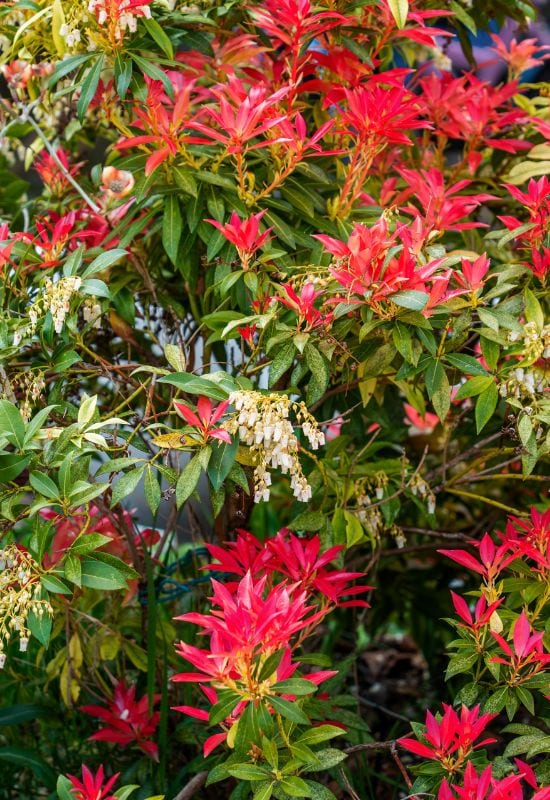
‘Red Head’ Japanese Andromeda us a medium sized variety of the evergreen Asiatic shrub with a very particular characteristic. New foliage emerges with a bright pink red color, and only later does it mature to deep and glossy green.
So, you get a dense, very lush bush of elliptical and pointed leaves that will stay on all year round. The blooms will come in clusters of scented, urn shaped white to cream flowers adding a delightful fragrance to your garden. An absolutely invaluable asset for its vitality and florid look, you will need to keep in mind that this bush is toxic if you ingest any part of it.
Great for accent as well as to give you red and green foliage and impressive blooms, you could use ‘Red Head’ Japanese Andromeda in hedges or screens, but also as a specimen or for foundation planting. Its fiery beauty is always a great show!
Red Chokeberry (Aronia arbustifolia ‘Brillantissima’)
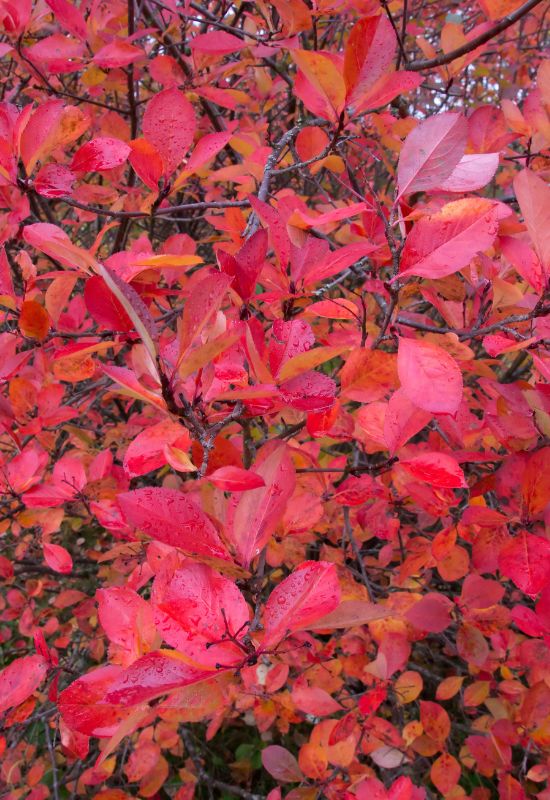
The red berries, glossy, in very dense and big clusters that come on the branches of red chokeberry will keep you company all the way into winter. And so will birds who love them. That is, unless you harvest them for delicious jams first.
But there is more! The dark green leaves, glossy and pointed, will turn to blush to blood color in the fall, for an explosion of fire in your garden. Spring will come with its huge blossom of white to pink flowers, which will attract lots of butterflies and pollinators.
‘Brillantissima’ is the cultivar of red chokeberry that most exalts the color red in its foliage, and because its fruits are glossier than in other varieties. It has won the Gold Medal Award by the Pennsylvania Horticultural Society and it is ideal for woodland gardens and naturalized areas. What is more, it is also suitable to wet gardens!
‘Compactus’ Burning Bush (Euonymus alatus ‘Compactus’)
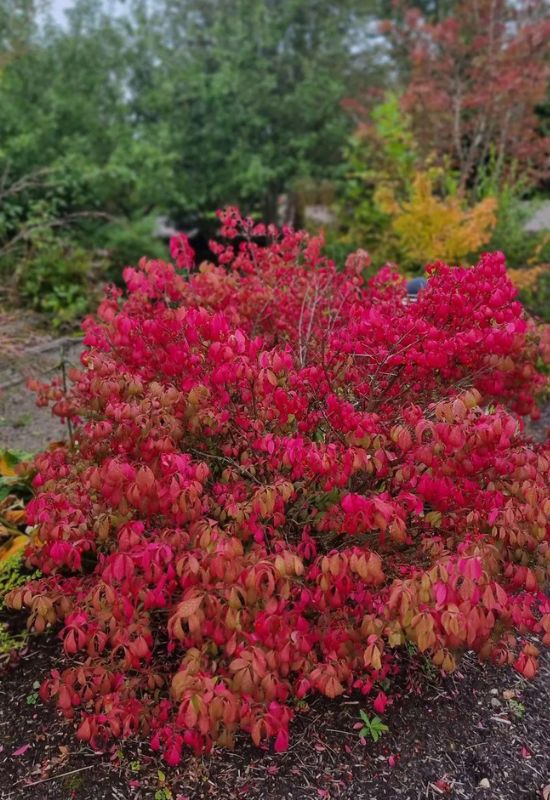
‘Compactus’ is an impressive variety of burning bush because of the color that its foliage takes on in fall: flaming scarlet red! While the leaves pendant, elliptical and lush on the reddish branches will are rich green from spring to summer, the end of year spectacle is literally jaw dropping.
When the profuse, non-showy greenish flowers are spent, then, you will get even more of our color… Yes, because reddish purplish fruits will follow and stay on for months, and then they ripen to orange red seeds, that stay on even in winter!
With some red all year round, ‘Compact’ burning bush is a winner of the Award of Garden Merit by the Royal Horticultural Society that you can have for fiery energy in shrub borders, screens or hedges, and – why not – also as a showy specimen plant!
‘Cardinal’ Redtwig Dogwood (Cornus sericea ‘Cardinal’)
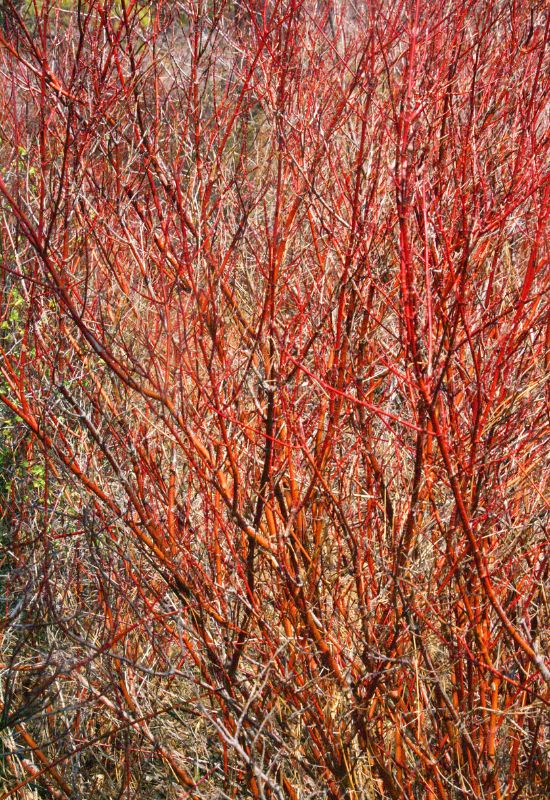
‘Cardinal’ redtwig dogwood has one thing that stays red all year round: all its branches! Noted for the exquisite cardinal tonality they have, it also has a suckering, cane like appearance that is at its best in winter, when the foliage drops.
The leaves will be green during spring and summer; however, they will take on a wine coloration when the season comes to a close. This way you will have a strong contrast most of the year, then a fading into flame like colors that has its summit when your garden most needs vibrancy. Add the black berries that stay in for months, and you can surely see why shrub is an invaluable addition to your garden!
Because it tolerates wet soil, ‘Cardinal’ redtwig dogwood is perfect for pond and stream sides. But don’t worry if you don’t have a water feature, it will bring its red beauty also to shrub borders or naturalized areas just as well!
Red All Year Round with Our Fiery Shrubs!
It is really hard to have some red all year round in a garden; but if you do, you will always have a strong, energetic color on display. There are some perennials that can help you achieve thus great effect, or…
Any of our shrubs has some red to offer for every season, with their foliage, berries, or sometimes, even just with their bark and branches. So, if you want this vibrant color in your garden, you know which shrub varieties you can grow in your green space now!

Written By
Adriano Bulla
After many years as an academic in London, Adriano Bulla became a writer, publishing books like A History of Gardening, Organic Gardening and Elements of Garden Design; he then decided to become a gardener, following his childhood dream, and has been following his dream writing and gardening professionally in Southern Europe, where he has specialized in new and innovative organic gardening fields and techniques, like permaculture, regenerative agriculture, food forests and hydroponics.

